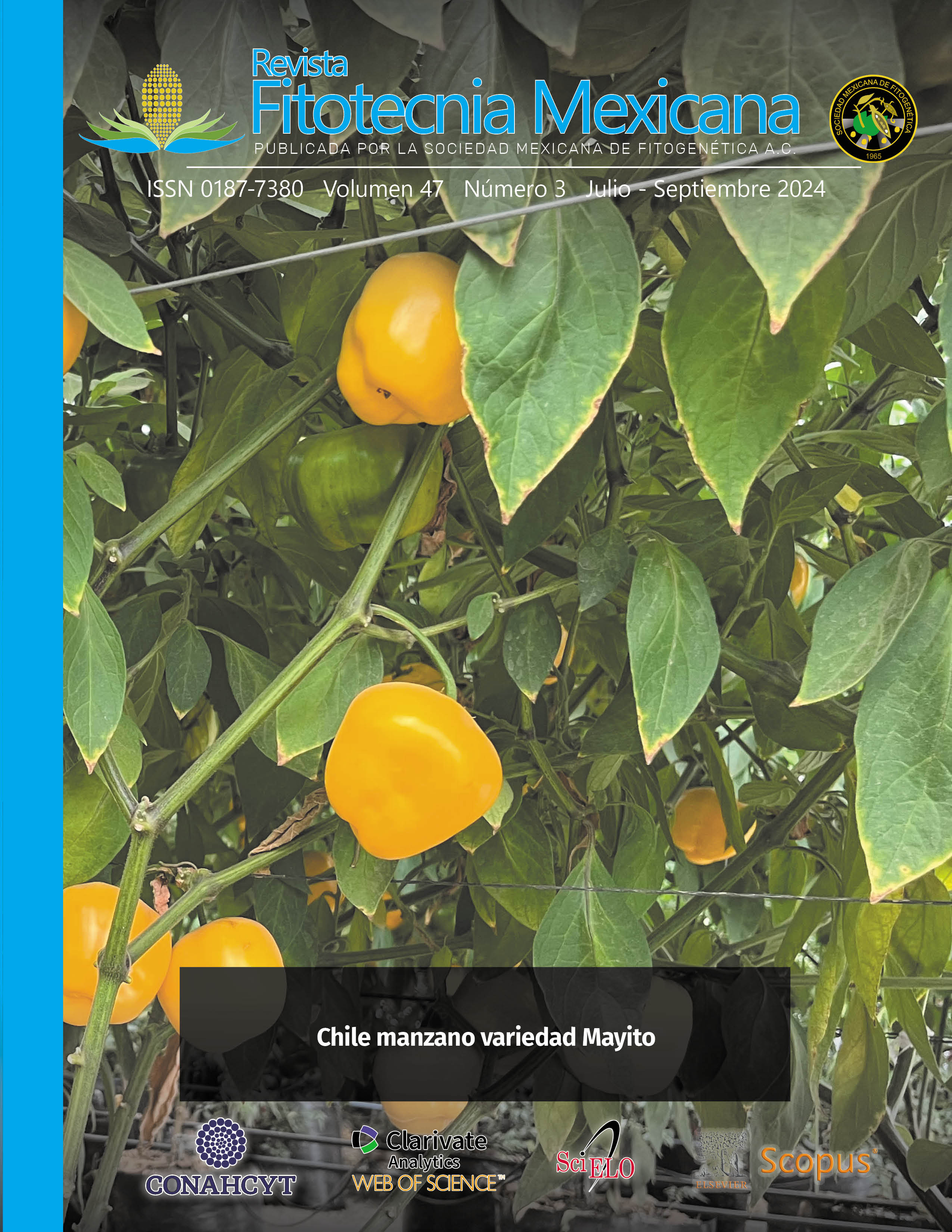MAYITO: NEW VARIETY OF MANZANO HOT PEPPER
Main Article Content
Abstract
In Mexico, the production of manzano chili (Capsicum pubescens) has had a significant increase, which has generated a production value that amounts to 405 million Mexican pesos (SIAP, 2022). The main producing entities are the State of Mexico, Puebla, Michoacán and Veracruz. Generally, production systems with this type of chili are semi-commercial, with areas that do not exceed five hectares, and are often associated with timber and fruit trees that provide shade for the chili plants. It is important to highlight that yields in these production systems are relatively low, ranging between 5 and 8 t ha-1 per year. According to Pérez and Castro (2012), an alternative to improve productivity is to implement intensive production systems in greenhouse conditions and with the use of improved varieties; In this way, these authors mentioned that up to 80 t ha-1 per year can be obtained, with high quality fruits, which satisfy the national and export markets.
Since 1994, the production and genetic improvement program for manzano chili began at the Chapingo Autonomous University, from which the new Mayito variety resulted. Obtaining this variety was carried out in two stages; In the first (1994), collections of creole varieties were carried out in different locations in the Mexican Republic (Zongolica and Huatusco in Veracruz; Tlatlauquitepec and Teziutlán in Puebla and San Cristóbal de las Casas in Chiapas) and a location in Peru (Province of Oxapampa ). For each of the six collections, three cycles of individual selection and self-fertilization were carried out. Outstanding plants in number of fruits, fruit size, fruit color (yellow) and vigorous plants were selected. With the six selected genotypes, interpopulation crosses were carried out using the Griffing Method II diallelic design, and the progenies were evaluated, where the Zongolica × Puebla hybrid was identified as outstanding in yield and fruit quality. This hybrid was registered with the SNICS in 2012, as Grajales St with folio 0706. In the second stage, the interpopulation variety Grajales St. was used, from which eight lines outstanding in yield, fruit quality, growth habit were selected. and precocity (L1, L2, L3, L4, L5, L6, L7 and L8), five cycles of selfing were applied to these lines (S5); Afterwards, crosses were carried out between the lines according to the Griffing Method II diallel design and 28 single-cross hybrids were obtained. In the evaluation of these, five outstanding hybrids were identified for their yield and fruit quality, and they were registered with the SNICS in 2015, with the names of Dali (L1 × L3), Jhos (L3 × L4), Claris (L3 × L8), Maruca (L1 × L2) and Yoli (L7 × L8). As can be seen, in three of the five hybrids the L3 line was involved as the parent; four more self-fertilization cycles were applied to it, from 2016 to 2019, for a total of nine (S9). The varietal characterization of this genotype was carried out in 2019 and 2021, in accordance with the technical guide for the varietal description of Manzano chili (SNICS, 2017) under greenhouse conditions in the experimental agricultural field of the Autonomous University Chapingo, and was demonstrated the distinction, homogeneity and stability of the new Mayito variety.
Mayito is a variety with a short stem, with one to three shortened internodes starting from the first fork (Figure 1A), with a very short length of the internode on the outer lateral branches (Figure 1B), the nodes show weak anthocyanin pigmentation and pubescence. weak; the leaf blade is long and narrow (Figure 1C), with a medium flat shape (Figure 1D), and green in color with medium intensity; the cross-sectional profile is concave (Figure 1E) and shows no roughness. As for the flower, the petals have weak anthocyanin pigmentation (Figure 1F), while the style is medium intensity. The fruit, At the beginning of maturity, it is light green (Figure 2A) and has a medium size, with a trapezoidal shape (Figure 2B), and as it matures its color changes to yellow with medium intensity (Figure 2C); the apex is shallow (Figure 2D); three locules predominate inside the fruit (Figure 2E) and the thickness of the pericarp ranges from 5 to 6.5 mm. The flowering of the plant begins 71 days later transplantation (ddt), the beginning of fruit maturity is presents at 181 days.
The Mayito variety is classified as early, in contrast to Grajales St., Maruca and Dali, which are classified as late; In addition, Mayito represents an excellent option for intensive production in greenhouse conditions due to the short size of the plant, due to its short internodes on the main stem and lateral branches. Due to its adaptability, Mayito can be grown in various manzano chile producing regions in Mexico, such as Coatepec Harinas, Sultepec and Texcoco in the State of Mexico; Tacámbaro and Zitácuaro in Michoacán, and in the Sierra Norte of Puebla. Its yield can reach up to 110 t ha-1 per year and is obtained from the sum of the harvests in three production flows, with eight harvests per flow and one harvest per week.
The Mayito variety is registered in the National Catalog of Plant Varieties of the National Seed Inspection and Certification Service (SNICS, 2023) with the number CHL-061-120723 and has the title of breeder 3290 for the Chapingo Autonomous University, awarded the October 16, 2023, valid until September 25, 2038. Seed is available in the Experimental Agricultural field of the Autonomous University Chapingo, Texcoco, State of Mexico, CP 56230, Mexico.

